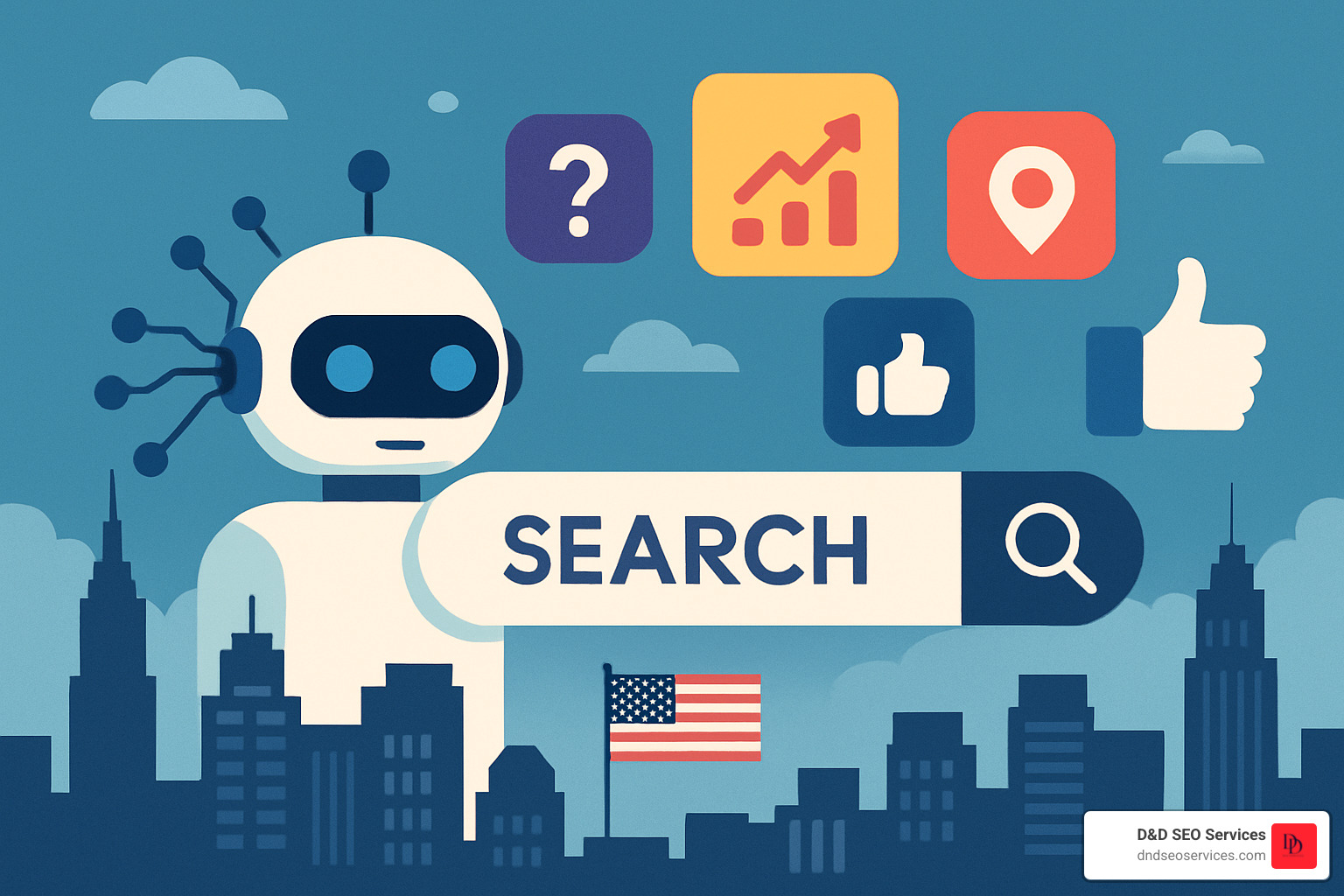The AI Search Revolution Is Here: Your Business Visibility Is at Stake
Answer engine optimization best practices are now essential for businesses that want to stay visible as AI transforms how customers find information online. With over 400 million people using ChatGPT weekly and 65% of Google searches ending without a click, the old rules of SEO aren’t enough anymore.
Key Answer Engine Optimization Best Practices:
- Structure content for direct answers – Place clear, 40-50 word answers immediately after question headings
- Implement FAQ schema markup – Help AI engines understand your Q&A content format
- Build topic authority – Create content clusters around related questions in your industry
- Optimize for featured snippets – Use bullet points, numbered lists, and tables for easy extraction
- Focus on E-E-A-T signals – Demonstrate expertise, experience, authoritativeness, and trustworthiness
- Monitor AI citations – Track mentions in ChatGPT, Perplexity, and Google AI Overviews
- Use conversational language – Write how people actually ask questions, not how they type keywords
The shift is dramatic. Stack Overflow saw an 18% traffic drop after ChatGPT launched, while NerdWallet grew revenue 35% despite losing 20% of website visitors. Answer engines don’t just rank content – they cite it directly.
This means your business can earn visibility even without ranking on page one of Google. But it also means you could become invisible if you don’t adapt to how AI systems find and present information.
I’m Danielle Birriel, founder of D&D SEO Services, and I’ve spent 12+ years helping local businesses steer major search changes – from mobile-first indexing to Core Web Vitals. Now I’m focused on answer engine optimization best practices that help my clients get cited by AI systems and maintain visibility in this new search landscape.
Why AEO Is Critical in the AI Search Era
The numbers tell a story that’s impossible to ignore. We’re living through the most dramatic shift in search behavior since Google first appeared on our screens.
Think about your own search habits lately. You’ve probably noticed that 80% of searchers now rely on zero-click results for at least 40% of their searches. That means people are getting their answers directly from the search results page, without ever clicking through to a website.
The trend is accelerating fast. 65% of Google searches now end without a click to any website. Meanwhile, 45% of Millennials have switched to using social media for search instead of traditional search engines. And here’s the kicker: Gartner predicts that 25% of organic traffic will shift to AI chatbots by 2026.
This isn’t just about Google anymore. Perplexity is handling over 100 million queries every week, and Google AI Overviews now serve over 1 billion users. This academic study on AEO reveals just how fundamentally answer engines are changing the way information gets finded and consumed.
The user intent shift runs deeper than most people realize. Searchers aren’t just typing “best running shoes” anymore. They’re asking complete questions like “What are the best running shoes for flat feet under $150?” These conversational queries demand conversational answers, not pages stuffed with keywords.
What’s fascinating is the citation economy that’s emerging around AI answers. When ChatGPT or Perplexity cites your content, you’re essentially getting a digital endorsement at massive scale. Latest research on zero-click search shows something remarkable: 85% of sources cited in Google AI Overviews don’t appear on page one of traditional search results.
This creates incredible opportunities for businesses that understand answer engine optimization best practices. You can now earn visibility for your expertise without having to compete for those ultra-competitive top rankings.
Slot-Machine Results & Brand Visibility Volatility
Here’s something that catches most business owners off guard: answer engines behave more like slot machines than vending machines. The same exact query can return completely different sources and citations depending on when you ask it.
I’ve seen this with our clients. A local contractor might get cited by ChatGPT for “emergency roof repair tips” one week, then completely disappear from the same query the next week. This probabilistic nature of AI answers means you need multiple content touchpoints to maintain consistent visibility.
The silver lining? There’s still a significant first-mover advantage up for grabs. Most businesses haven’t adapted their content for AI consumption yet, which creates real opportunities for those who implement answer engine optimization best practices early.
The key is understanding that AI systems don’t just want good content – they want content that’s structured, authoritative, and easy to extract. When you get this right, you can earn citations even when bigger competitors dominate traditional search results.
Answer Engine Optimization Best Practices Checklist
After working with hundreds of local businesses and analyzing thousands of AI citations, I’ve developed a comprehensive checklist of answer engine optimization best practices. These aren’t theoretical strategies pulled from a textbook – they’re battle-tested approaches that actually work in the real world.
Think of this as your roadmap for getting your business cited by AI systems. Every recommendation here comes from watching what works (and what doesn’t) when ChatGPT, Perplexity, and Google AI Overviews decide which sources to trust and cite.
The foundation starts with your content structure. You need to place direct answers within the first 50 words of each section – no beating around the bush. AI systems scan for immediate value, not lengthy introductions. Your question-based H2 and H3 headings should sound like real questions people ask, and your 40-50 word FAQ answers need to be crystal clear for snippet optimization.
Here’s what many businesses miss: conversational language matching natural speech patterns isn’t just nice to have – it’s essential. People don’t ask Siri “plumber Fort Myers Florida services” – they say “Who’s a good plumber near me?” Your content needs to match how people actually talk.
Building content clusters around related topics demonstrates the kind of topical authority that AI systems love. Instead of one lonely page about AC repair, create a comprehensive resource covering every angle your customers might explore.
On the technical side, FAQ schema markup (FAQPage, HowTo, QAPage) acts like a direct line to AI systems, telling them exactly how to understand and extract your content. Speakable schema for voice search is becoming increasingly important as more people use voice assistants. Don’t forget descriptive image alt text – AI systems analyze images for context too.
Your clean HTML structure with proper heading hierarchy and mobile-first responsive design create the foundation that everything else builds on. If AI systems can’t easily crawl and understand your site structure, even the best content won’t get cited.
Authority signals separate the businesses that get cited from those that get ignored. Author bios with credentials tell AI systems who’s behind the information. Expert quotes and citations add credibility, while original data and research positions you as a primary source rather than just another opinion.
Customer reviews and testimonials provide social proof, and industry awards and certifications demonstrate recognized expertise. These elements work together to build the kind of trust that AI systems look for when deciding which sources to cite.
Your distribution strategy amplifies everything else. Multi-platform content presence and social media engagement create multiple touchpoints for AI systems to find your content. Guest posting on authoritative sites and digital PR with brand mentions build the external validation that boosts your citation chances.
Local directory listings remain crucial for businesses serving specific geographic areas like Naples, Cape Coral, or Tampa Bay.
| Optimization Type | AEO Focus | GEO Focus | LLM-SEO Focus |
|---|---|---|---|
| Primary Goal | AI citation and mentions | Generative search visibility | Language model optimization |
| Content Format | Q&A, FAQ, direct answers | Comprehensive guides | Structured, semantic content |
| Technical Approach | Schema markup, snippets | Entity optimization | Training data contribution |
| Measurement | Citation tracking | Generative SERP presence | Model inclusion rates |
Answer Engine Optimization Best Practices for Content & Intent
The foundation of effective AEO lies in understanding how AI systems actually process and present information. Unlike traditional SEO, where keyword density and backlinks dominated the game, answer engine optimization best practices prioritize clarity, authority, and precise user intent alignment.
Structure your content like you’re having a conversation with a knowledgeable friend. Start each section with a clear, direct answer to the implied question. If your H2 asks “How to Fix a Leaky Faucet,” your opening should immediately deliver: “To fix a leaky faucet, turn off the water supply, remove the handle and packing nut, replace the O-ring and washer, then reassemble. Most leaks occur due to worn washers or O-rings that cost under $5 to replace.”
No fluff, no lengthy setup – just the answer people need.
Building question clusters transforms your content from isolated pages into comprehensive resources. Instead of targeting individual keywords, create content ecosystems around related questions. If you’re a Fort Myers HVAC contractor, don’t just write about “AC repair.” Build a cluster covering how to tell if your AC needs repair, common problems in Florida’s humidity, when to repair versus replace, and emergency warning signs.
This approach demonstrates topical authority and dramatically increases your chances of citation across multiple related queries. AI systems love sources that can answer follow-up questions without sending users elsewhere.
Mastering semantic SEO means understanding that AI systems grasp context and relationships between concepts. Use synonyms, related terms, and natural language variations. Instead of repeating “plumber Fort Myers” throughout your content, weave in variations like “Fort Myers plumbing contractor,” “local plumber,” and “plumbing services in Southwest Florida.”
More info about Semantic SEO – this approach helps AI systems understand your content’s full context and relevance rather than just matching keywords.
Matching user intent precisely separates the content that gets cited from the content that gets ignored. Research shows that AI systems prioritize content that delivers exactly what the query implies over keyword-optimized pages. If someone asks “best restaurants near me,” they want recommendations, not a history of restaurants or a lecture about dining trends.
Structure your content to deliver precisely what each query demands, and you’ll see your citation rates climb.
Answer Engine Optimization Best Practices for Schema & SERP Features
Schema markup serves as your direct communication channel with AI systems. It provides the structured context that helps answer engines understand and extract your content accurately – think of it as giving AI systems a roadmap to your most important information.
Priority schema types for AEO include FAQPage schema for marking up your FAQ sections, which significantly increases your chances of featured snippet selection. HowTo schema works perfectly for step-by-step guides and tutorials, while Speakable schema optimizes your content for voice search and smart speakers. For local businesses, LocalBusiness schema remains essential whether you’re serving Cape Coral, Naples, or Tampa.
Featured snippet optimization acts as the gateway to AI citations. We’ve finded that content optimized for snippets has a 3x higher chance of being cited by AI systems. The winning formats include paragraph snippets with 40-50 word direct answers, list snippets using numbered or bulleted steps, and table snippets for comparison data and specifications.
People Also Ask (PAA) targeting reveals the questions AI systems associate with your topic. These PAA boxes are like getting a peek into AI thinking – they show you the related questions that strengthen your topical coverage and boost citation opportunities.
Image optimization for AI is becoming increasingly sophisticated. AI systems now analyze images for context, not just keywords. Use descriptive alt text that explains both what’s in the image and its relevance to the content. For a local business, this might be: “Licensed plumber repairing water heater in Fort Myers home, showing proper safety procedures and tools.”
More info about On-Page SEO – comprehensive on-page optimization creates the strong foundation that supports your AEO efforts by helping AI systems understand and trust your content.
FLIP Framework & /llms.txt: Future-Proofing Your Visibility
The FLIP Framework represents the cutting edge of answer engine optimization best practices. It’s specifically designed to prompt AI systems to fetch and cite fresh, relevant content rather than relying on stale information.
Freshness means updating your content regularly with new data, examples, and insights. AI systems increasingly favor recent information for time-sensitive queries. This doesn’t mean rewriting everything monthly – it means keeping your core content current with fresh examples, updated statistics, and recent developments in your field.
Local intent requires including local signals like city names, regional specifics, and local context throughout your content. For businesses in markets like Orlando, Miami, or West Palm Beach, this means mentioning local regulations, climate considerations, or regional preferences that make your advice more relevant and trustworthy.
In-depth context goes beyond answering the main query to addressing follow-up questions readers might have. Don’t just explain how to fix something – explain why it breaks, how to prevent it, and when to call a professional. This comprehensive approach positions you as the go-to source for complete information.
Personalization uses language and examples that resonate with your specific audience. A Denver HVAC company should reference altitude effects on heating systems, while a Miami contractor should focus on humidity challenges and hurricane preparedness. This specificity signals to AI systems that you understand your market deeply.
The /llms.txt standard represents an emerging opportunity to provide AI-friendly documentation alongside your regular HTML content. Think of it as creating a direct pipeline to AI training data. While still experimental, early adopters are seeing improved citation rates as AI systems can more easily understand and extract their key information.
Technical & Off-Site Levers to Boost AI Visibility
Technical SEO remains crucial for AEO success, but with some key differences. AI systems need to crawl, understand, and trust your content before they’ll cite it.
Crawlability and Indexation:
- Maintain a clean XML sitemap updated within 24 hours of new content
- Ensure fast page load times (under 2.5 seconds)
- Use clean HTML structure with proper heading hierarchy
- Implement internal linking to distribute authority
Core Web Vitals Impact:
While AI systems don’t directly measure Core Web Vitals, they do favor content from sites that provide good user experiences. Poor technical performance can indirectly hurt your AEO efforts by reducing overall site authority.
Mobile-First Optimization:
With voice search growing rapidly, mobile optimization is critical. AI systems often pull content for voice responses, and mobile-friendly formatting improves extraction accuracy.
Traditional link building still matters, but the focus shifts to editorial links from authoritative sources. These links signal to AI systems that your content is trustworthy and worth citing.
Digital PR and Brand Mentions:
Unlinked brand mentions across the web contribute to AI training data. The more your brand appears in authoritative contexts, the more likely AI systems are to recognize and cite your expertise.
More info about AI-Powered SEO Services – our technical approach combines traditional SEO foundations with AI-specific optimizations.
Build Authority & Trust for AI Citations
Authority and trust are the strongest signals for AI citation. Here’s how to build them systematically:
Original Research and Data:
Create and publish original studies, surveys, or data analyses. AI systems heavily favor unique insights over rehashed information. For local businesses, this might mean surveying customers about local preferences or analyzing regional trends.
Expert Quotes and Interviews:
Include quotes from recognized experts in your field. This adds credibility and increases the likelihood of citation. For a Jacksonville law firm, this might mean quoting state bar officials or legal scholars.
E-E-A-T Demonstration:
- Experience: Share specific examples and case studies
- Expertise: Display credentials, certifications, and awards
- Authoritativeness: Earn mentions in industry publications
- Trustworthiness: Provide clear contact information and transparent business practices
Customer Reviews and Testimonials:
User-generated content signals trust to AI systems. Encourage detailed reviews that mention specific services and outcomes.
Monitor & Iterate on Citations and Mentions
Tracking AEO success requires new metrics and tools:
Manual Citation Tracking:
- Search your target queries on ChatGPT, Perplexity, and Claude monthly
- Document when and how your content gets cited
- Track citation consistency across different AI platforms
AI Overview Monitoring:
- Use tools like the AI Overview Impact Analysis Chrome extension
- Monitor which competitor content gets cited
- Adapt your content structure based on successful formats
Visibility Score Tracking:
- Track mentions across AI platforms
- Monitor brand name recognition in AI responses
- Measure citation share of voice for key topics
The key is consistency. Set up monthly audits to track your progress and identify opportunities for improvement.
Frequently Asked Questions about Answer Engine Optimization Best Practices
Let me address the most common questions I get from business owners who are just finding answer engine optimization best practices. These are real concerns from real people trying to steer this new search landscape.
What’s the main difference between AEO and traditional SEO?
The fundamental shift is from chasing rankings to earning citations. Traditional SEO was all about getting your page to rank #1 for “best pizza Fort Myers” so people would click through to your website. AEO is about becoming the answer that ChatGPT or Google AI Overview shares directly with users – even if they never visit your site.
Think of it this way: SEO says “Come to my website to find the answer.” AEO says “Here’s the answer, and by the way, it came from this trusted source.”
The intent focus is completely different too. While SEO might optimize for keyword phrases, AEO optimizes for conversational questions like “Where can I find the best pizza in Fort Myers for a family dinner with kids?” The full context matters because that’s how people actually talk to AI assistants.
This doesn’t mean traditional SEO is dead – it means we need to think beyond just driving traffic. Sometimes being cited as the expert source is more valuable than getting a website visit.
How long does it take to see AEO results?
Here’s the encouraging news: AEO results typically show up faster than traditional SEO rankings. I’ve seen well-optimized content start getting cited by AI systems within 4-8 weeks, especially when it follows proven answer engine optimization best practices.
But there’s a difference between getting your first citation and achieving consistent visibility. That usually takes 3-6 months of steady optimization work. It’s like building a reputation – the first mention might come quickly, but becoming a go-to source takes time.
Your timeline depends heavily on your starting point. Businesses with strong authority signals and quality content see results faster, while newer websites need more time to build trust with AI systems. The good news is that training cycles for AI models mean your content gets fresher consideration than in traditional search.
One thing I tell my clients: don’t expect overnight miracles, but do expect to see progress much faster than old-school SEO. Content freshness plays a bigger role in AEO, so regular updates can accelerate your results.
Which schema types matter most for AEO?
After optimizing hundreds of pages for AI visibility, I’ve found that three schema types deliver the biggest impact for answer engine optimization best practices:
FAQPage Schema is your best friend for direct content extraction. When you mark up your Q&A sections properly, AI systems can easily identify and pull your answers for citations. This is especially powerful for local businesses answering common customer questions.
HowTo Schema works beautifully for step-by-step guides and tutorials. If you’re explaining processes – whether it’s “how to prepare for a roof inspection” or “how to choose the right attorney” – this schema helps AI systems understand and present your expertise clearly.
Speakable Schema is crucial as voice search continues growing. This tells AI systems which parts of your content work best for spoken responses, making you more likely to get cited in voice search results.
For local businesses, I always recommend adding LocalBusiness schema too. It’s essential for location-based queries, especially in competitive markets where local context matters. This helps AI systems understand your geographic relevance and authority.
The key is implementing these schema types correctly, not just adding them for the sake of it. They need to accurately reflect your content structure to be effective.
Conclusion
The search landscape has fundamentally changed, and answer engine optimization best practices aren’t just a nice-to-have anymore – they’re absolutely essential for staying visible when your customers are asking AI for answers instead of clicking through search results.
Think about it: when 65% of Google searches end without anyone clicking on a website, you need to be where people are actually getting their information. That’s inside AI-generated answers, voice responses, and direct citations.
The exciting part? You don’t need to throw out everything you know about SEO. Answer engine optimization best practices work alongside your existing strategy, making it stronger and more future-proof. You’re still building authority and creating great content – you’re just making sure AI systems can find, understand, and cite it.
What we’ve learned from helping businesses across Fort Myers, Cape Coral, Tampa, Orlando, and beyond is that the companies adapting to AI search now are seeing real results. They’re getting cited by ChatGPT, appearing in Google AI Overviews, and maintaining visibility even as search behavior shifts dramatically.
The key is taking a complete approach. Your content needs to answer questions directly. Your technical setup needs to support AI crawling and understanding. Your authority signals need to tell AI systems you’re trustworthy enough to cite. When all these pieces work together, you create a powerful presence in the new search ecosystem.
At D&D SEO Services, we’ve watched this change happen in real-time and helped our clients stay ahead of it. The businesses that wait to adapt will find themselves invisible in a world where AI answers most questions before users ever see traditional search results.
The future of search is here, and it’s conversational, contextual, and powered by AI. By implementing these answer engine optimization best practices, you’re not just keeping up with change – you’re positioning your business to thrive as more people turn to AI for information every day.
Ready to make sure your business stays visible as search continues evolving? More info about AI-Overview Optimization for Local SEO – let’s work together to ensure your expertise gets the AI citations it deserves.










